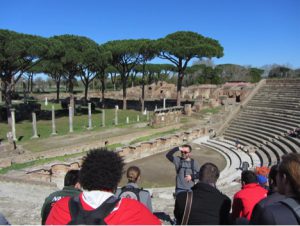
Andrew Merced ’19 — Rome is easily one of the most beautiful cities in the world. It is also one of the most iconic. When people think of empires and grand arenas, Rome is the first to come to mind. The city is ancient, yet it remains one of the busiest cities in the world. While in Rome, we saw numerous monuments and important sites dedicated to the Roman Empire as well as the beginnings of Christianity. The locations we visited include the Theater of Pompey, the Pantheon, the Colosseum, the Vatican, the Roman Forum, and much more. We took countless steps to see as much as we possibly could for the duration of the trip. We explored multiple streets and buildings within the Roman city of Ostia while also exploring the vast amounts of streets in Rome. As for the food, few can equal the fresh tastes and smells we encountered as a class. The pasta is extremely flavorful, and the meats are seasoned to perfection. There was not a single meal that did not exceed my expectations. Some of the most delicious meals included scamorza with salmon, fettucine, lamb, and numerous other foods worth trying. Some of the best portions of the trip included the on-site presentations given by Wabash students. Each presentation dove into the history and context of different locations and artworks. It was interesting to have fellow Wabash men explain such important monuments to the class, and it was one of the best experiences to have.
From the trip, I have learned how complicated Constantine actually was. His belief in Christianity is clearly seen while also being questioned because of various things he did while emperor. He converted to Christianity, giving the new religion a great deal of power and sway, and yet, he did not forget his pagan history. The readings done in class were supported by the evidence we saw in person. Rome, although full of churches now, still maintains pagan influences in each church we saw. In Santa Costanza, for example, the symbols within the church are open for interpretation because the images within the church can be viewed as either Christian or pagan. Such an ambiguous representation is the best way to explain Constantine’s true faith. There is an argument to be made for both sides. In the end, the trip itself enabled us, as a class, to grasp a better understanding of who Constantine truly was and how Christianity grew to its current size and stature. Rome holds so many secrets, and it is because of this that the phrase “Rome is a city built upon itself” continues to ring true.